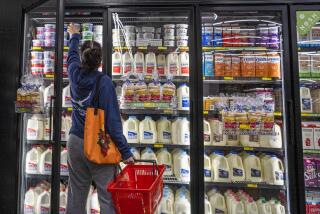Reports Show Recovery Is in Holding Pattern : * Economy: Retail sales post a small increase, while wholesale prices remain almost level.
- Share via
WASHINGTON — Retail sales barely rose in September aside from a spurt in demand for new cars and wholesale prices were stable, the government reported Friday, showing that the economy is caught in a holding pattern after a year-long recession.
Economists said the economic recovery is now so fragile--crimped by a poor job market and slim gains in consumer incomes--that the Federal Reserve will be forced to cut interest rates again soon.
“The reports point to further easing in monetary policy,” said Norman Robertson, chief economist at Mellon Bank in Pittsburgh. “There’s a lot of pressure on the Fed to ease monetary policy more.”
The Commerce Department said retail sales rose 0.7% in September because of a burst of car buying, and the Labor Department reported that wholesale prices inched up a scant 0.1%.
Many economists believe that the recession that began in July, 1990, ended in the second quarter this year, but concern is rising about how to sustain growth.
Retail sales--a measure of vital consumer spending that fuels two-thirds of economic activity--were sluggish aside from new-car sales, which were swelled by big purchases by rental companies. Sales had fallen 0.6% in August.
Excluding cars, sales gained only a fractional 0.1% last month after a 0.2% fall in August. Cars account for about 20% of total sales.
Meanwhile, the small 0.1% rise in wholesale prices came after a 0.2% August rise, showing that inflation remains under control.
So far this year the producer price index has fallen at a seasonally adjusted 0.9% annual rate, the best performance since 1986.
The sluggish recovery has put added pressure on the Fed to cut interest rates, since government spending--another way to help the economy--has been held in check by the huge deficit. Underscoring the lack of money, President Bush Friday vetoed a $6.4-billion bill to help up to 2 million Americans whose unemployment benefits have expired.
“It’s unfortunate that fiscal policy now is paralyzed . . . so that the Fed is carrying the whole load of trying to add stimulus,” Robertson said.
The White House said the retail sales and inflation reports were “extremely good news” and renewed calls on the Fed to cut rates. The central bank already has cut its trend-setting discount rate three times in 1991 to a current 18-year low of 5%.
Nonetheless, late in the morning, the Fed signaled in the money markets that it was keeping interest rates on hold by draining reserves from the banking system.
Economists are now wondering how long the Fed can wait before it eases credit again.
“It may be a statistical recovery, but it feels like a recession,” Robertson said. “At this stage, we should be seeing hirings on a large scale, but we’re not only not seeing hirings, we’re seeing firings.”
The unemployment rate has topped 6% for the past nine months and new applications for unemployment benefits rose once more in late September.
Nonetheless, retail sales were higher in two out of three months during the July-September third quarter--rising 0.4% in July and0.7% last month, but falling 0.6% in August.
Producer Price Index
For finished goods
Seasonally adjusted change from prior month
Sept., ‘91: +0.1%
Aug., ‘91: ‘91: +0.2%
Sept., ‘90: +1.3%
Source: Labor Department
Retail Sales
Seasonally adjusted, billions of dollars
Sept., ‘91: $153.3
Aug., ‘91: $152.2
Sept., ‘90: $152.5
Source: Commerce Department
More to Read
Inside the business of entertainment
The Wide Shot brings you news, analysis and insights on everything from streaming wars to production — and what it all means for the future.
You may occasionally receive promotional content from the Los Angeles Times.










